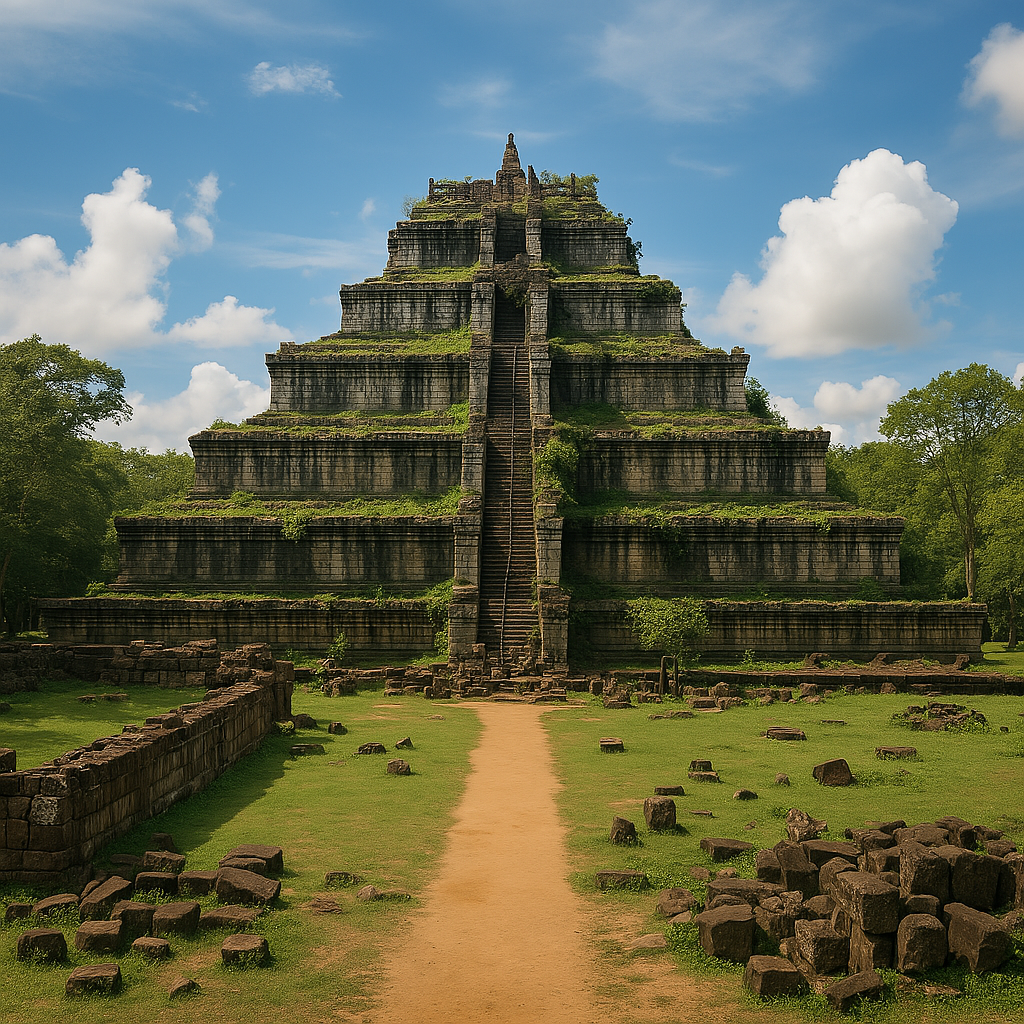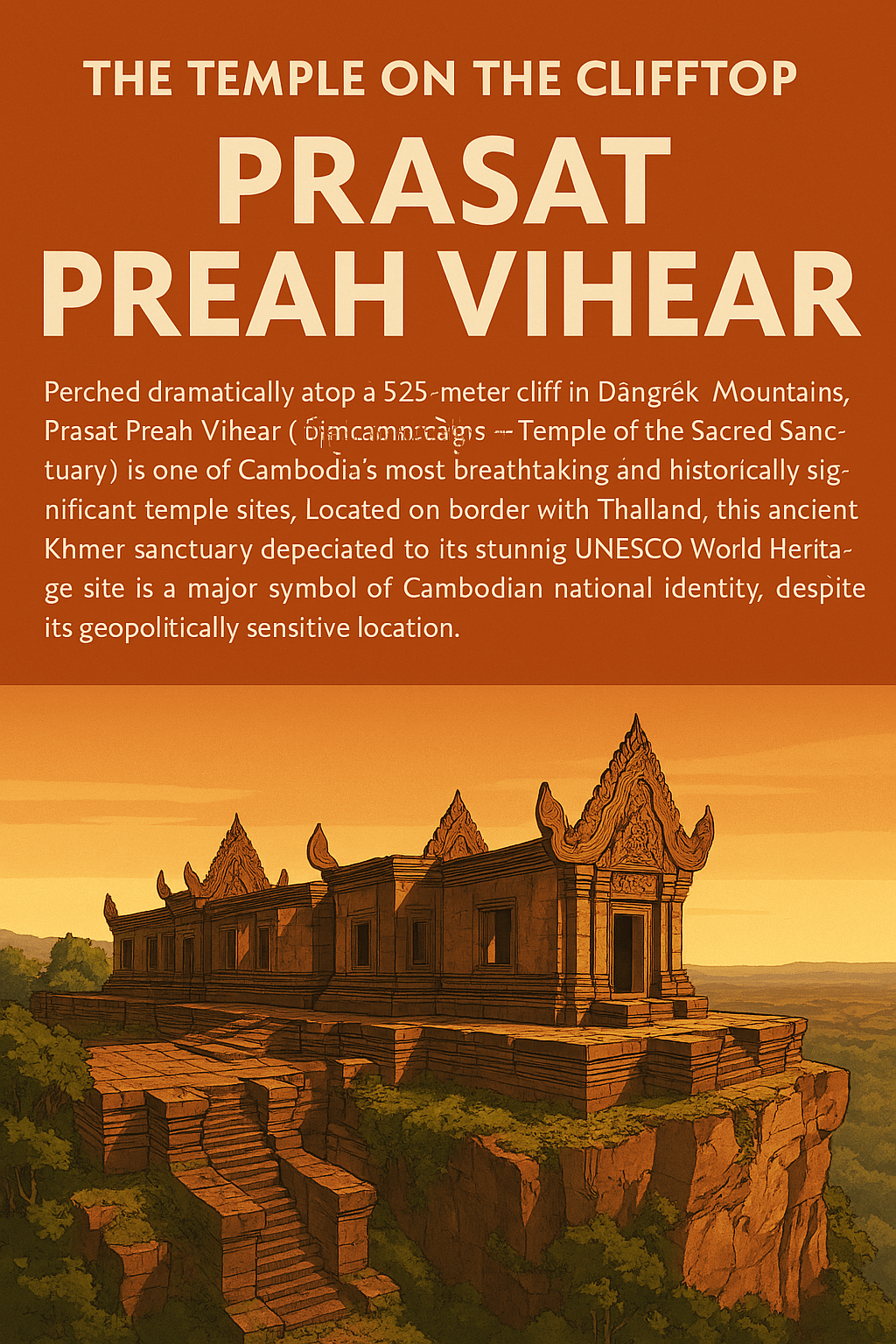Nestled at the very heart of the ancient walled city of Angkor Thom, Bayon Temple stands as one of the most captivating and instantly recognizable monuments within the Angkor complex. Built in the late 12th to early 13th centuries primarily under the reign of the great Khmer king Jayavarman VII, Bayon is famed for the multitude of colossal, serene stone faces that smile enigmatically from its many towers. Serving as Jayavarman VII’s state temple, it represents a distinct shift towards Mahayana Buddhism in Khmer architecture and offers invaluable glimpses into the life of the Angkorian Empire.
The Gaze of Compassion?: Meaning Behind the Faces

The defining feature of Bayon is undoubtedly the collection of giant smiling faces – over 200 are estimated to remain – carved onto the four sides of some 50 towers. These serene visages, with closed or downcast eyes and gentle smiles, gaze out towards the cardinal directions, blanketing the temple complex in an atmosphere of profound peace and mystery. Their exact meaning and identity remain subjects of scholarly debate, contributing significantly to the temple’s allure.
King and Temple: Jayavarman VII’s Vision

Bayon was constructed during the prolific reign of Jayavarman VII (c. 1181–1218 AD), a king renowned for his extensive building programs and his fervent devotion to Mahayana Buddhism. After reclaiming the capital from Cham invaders, Jayavarman VII established Angkor Thom (“Great City”) as his new royal seat, placing Bayon at its geographical and symbolic center. The temple served as his official state temple, embodying his religious beliefs and imperial authority.
Center of the Realm: Role in Ceremonies

As the state temple located at the heart of the capital, Bayon was the epicenter of religious and royal life during Jayavarman VII’s reign. It likely hosted major state ceremonies, rituals presided over by the king, and Mahayana Buddhist practices. Its central position underscored the king’s role as a righteous Buddhist ruler (often identified with the Bodhisattva Lokeshvara) mediating between the heavens and the earth, radiating power and compassion throughout his empire.
Life Carved in Stone: Bas-Reliefs and Layout

Unlike the expansive, classical layout of Angkor Wat, Bayon features a more complex, concentrated, multi-level structure with somewhat labyrinthine galleries and passages. Its most remarkable narrative feature lies in the extensive bas-relief carvings adorning the walls of the outer galleries. These reliefs are particularly valuable because, alongside mythological scenes and historical accounts, they offer uniquely vivid and detailed depictions of everyday life in 12th-century Cambodia:
- Market Scenes: Buying and selling goods, food preparation, interactions between vendors and customers.
- Domestic Life: Cooking over fires, childbirth, household activities.
- Entertainment: Cockfighting, games, musicians, dancers.
- Construction and Labor: Scenes possibly depicting the building of the temples themselves.
- Historical Events: Most famously, a detailed depiction of a naval battle between Khmer forces and Cham invaders on the Tonle Sap lake, alongside various land battles and processions. These carvings provide an unparalleled window into the lives of ordinary Khmer people, complementing the more formal and epic narratives found at Angkor Wat.
Whose Face? Theories on Identity

The identity of the serene faces remains one of Angkor’s greatest mysteries. The main theories include:
- Lokeshvara (Avalokiteśvara): The Bodhisattva of Compassion, a central figure in Mahayana Buddhism. The faces, radiating benevolence in all directions, would represent Lokeshvara watching over the kingdom and its inhabitants. This aligns well with Jayavarman VII’s known devotion to this Bodhisattva.
- King Jayavarman VII: The faces as idealized portraits of the king himself, perhaps portrayed as Lokeshvara. This would emphasize the concept of the devaraja (god-king) adapted into a Buddhist context – the king as the earthly embodiment of the compassionate Bodhisattva. Facial similarities between the Bayon faces and known statues of Jayavarman VII lend support to this view.
- Brahma: A less common theory suggests the four faces represent the Hindu creator god Brahma, who is sometimes incorporated into Buddhist cosmology. Most scholarly consensus leans towards the faces representing Lokeshvara, likely incorporating idealized features of King Jayavarman VII, symbolizing the fusion of compassionate divinity and righteous kingship. The enduring ambiguity, however, is part of Bayon’s unique mystique.
Architectural Shift: From Hinduism to Mahayana Buddhism

Bayon marks a significant departure from the architectural style of the earlier, Hindu-dedicated Angkor Wat, reflecting the shift towards Mahayana Buddhism under Jayavarman VII:
- Cosmology: While Angkor Wat represents the Hindu cosmos centered on Mount Meru, Bayon’s complex structure and face towers likely embody Mahayana Buddhist concepts, perhaps representing layers of Buddhist heavens or the omnipresence of the Bodhisattva.
- Layout: Bayon is more compact, vertically oriented, and feels more densely packed compared to Angkor Wat’s symmetrical, expansive plan.
- Iconography: The defining feature is the face towers, fundamentally different from Angkor Wat’s tiered towers representing mountain peaks. Buddhist motifs are prevalent.
- Reliefs: Bayon’s focus on historical events and detailed scenes of daily life contrasts with Angkor Wat’s emphasis on Hindu epics and mythology.
- Construction: Evidence suggests Bayon may have been built more rapidly and perhaps with less consistently meticulous techniques than Angkor Wat, contributing to its more ruinous state in certain areas today.
Conclusion
Bayon Temple is an architectural and spiritual marvel, a unique testament to the vision of Jayavarman VII and the flourishing of Mahayana Buddhism in the Khmer Empire. Its enigmatic smiling faces, looking out over the ruins of Angkor Thom, continue to captivate and puzzle visitors. With its intricate galleries depicting vibrant scenes of historical and everyday life, and its distinct architectural language, Bayon offers a fascinating counterpoint to Angkor Wat and is crucial for understanding the evolution of Khmer art, religion, and society. Its mysterious allure and profound sense of peace make it an unforgettable landmark, resonating deeply with Cambodia’s past and present, cherished by people across the nation, including those in Battambang, as of April 2025.





